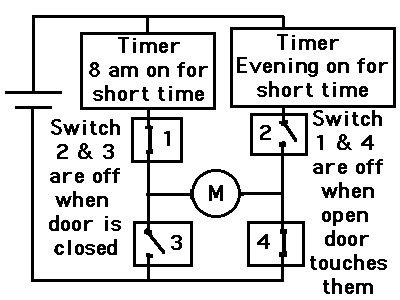Torbenc
Newbie level 5
Hi
Im building an automatic chicken door opener for my but are having some problems.
I had all parts laying around, and where I live a commercial door opener cost $300.
I have tried to assembly it as I thought it would work, but with no luck..
I have these parts:
2 x 12v timers (**broken link removed**
2 x Roller microswitches Switches - Microswitches - MCROLLER
1 x motor (from a electric drill - cheap and low gearet)
The plan was that timer 1 should open the relay at 8 a clock, microswitch 1 will let the motor turn clockwise, so it will open the door, when hitting microswitch 2, it will stop turning, and the current are set so the motor will turn counter clockwise.
At 21 a clock, timer 2 (or 1?) will again open the relay, and the door will close, hit microswitch 1, and set the current to clockwise.
Hope you understand my plan.
Im building an automatic chicken door opener for my but are having some problems.
I had all parts laying around, and where I live a commercial door opener cost $300.
I have tried to assembly it as I thought it would work, but with no luck..
I have these parts:
2 x 12v timers (**broken link removed**
2 x Roller microswitches Switches - Microswitches - MCROLLER
1 x motor (from a electric drill - cheap and low gearet)
The plan was that timer 1 should open the relay at 8 a clock, microswitch 1 will let the motor turn clockwise, so it will open the door, when hitting microswitch 2, it will stop turning, and the current are set so the motor will turn counter clockwise.
At 21 a clock, timer 2 (or 1?) will again open the relay, and the door will close, hit microswitch 1, and set the current to clockwise.
Hope you understand my plan.
